© Copyright Atlanta Coin Expositions, 2008-2025. All Rights Reserved.
Several of the links on the pages within this web site go to affiliate vendors.
A vendor affiliation can mean a small monetary compensation to the web site owner at no additional cost to you.
Several of the links on the pages within this web site go to affiliate vendors.
A vendor affiliation can mean a small monetary compensation to the web site owner at no additional cost to you.
Coin Show
Information
Shop
General
Next Monthly Coin Show
Coin Show - Monthly Notes from June 2019
These few examples show just a small cross section of the different items that can be found at the coin show each month.
Dealers offer numismatic collectibles from the ancients to the modern day, coins and currency. They also offer related items such as coin banks , stock certificates and money-related items. Visitors can also find jewelry, precious and semi-precious stones and many other treasures as well.
Visitors are welcome to bring items to sell to the dealers or to obtain a free verbal quote of the items' current value.
Mark your calendar and visit the next Greater Atlanta Coin Show on Sunday, July 14, 2019 in the Joe Mack Wilson ballroom to buy, sell, trade or just browse among the treasures on display in the dealers' showcases.
Dealers offer numismatic collectibles from the ancients to the modern day, coins and currency. They also offer related items such as coin banks , stock certificates and money-related items. Visitors can also find jewelry, precious and semi-precious stones and many other treasures as well.
Visitors are welcome to bring items to sell to the dealers or to obtain a free verbal quote of the items' current value.
Mark your calendar and visit the next Greater Atlanta Coin Show on Sunday, July 14, 2019 in the Joe Mack Wilson ballroom to buy, sell, trade or just browse among the treasures on display in the dealers' showcases.
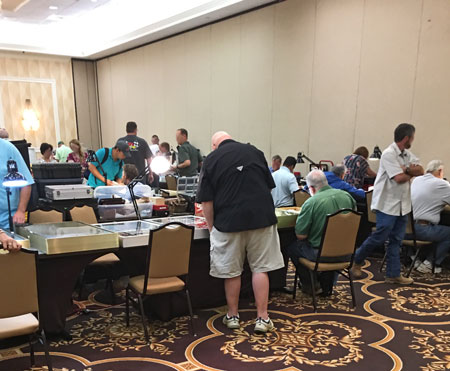
Dealers and their collectibles filled the June 2019 Greater Atlanta Coin Show for the many visitors to enjoy browsing, buying and selling among the treasures.
As always we appreciate the many visitors, our dealers, our security and the hotel's staff for making the coin show a fun place to spend a few hours each month.
For June, the weather presented rain in the early morning but mostly overcast skies with some sun throughout the afternoon.
As always we appreciate the many visitors, our dealers, our security and the hotel's staff for making the coin show a fun place to spend a few hours each month.
For June, the weather presented rain in the early morning but mostly overcast skies with some sun throughout the afternoon.
The hotel hosted in our space the previous night a 50th high school reunion for a couple of different high schools in the nearby area. We hope they enjoyed themselves.
During the day, we shared the hotel with at least one if not more churches that utilize the hotel's space for their worship services.
On the bourse, several discussions centered around how the price of metals - gold, silver, platinum and palladium - will react in the trading market after the new tariffs between us and China and other nations begin.
This month, we had people looking for the trime, three-cent silver coin. Did you know the US Mint produced the trime for postage?
Let's take a virtual look at just a few of the items on the June bourse.
During the day, we shared the hotel with at least one if not more churches that utilize the hotel's space for their worship services.
On the bourse, several discussions centered around how the price of metals - gold, silver, platinum and palladium - will react in the trading market after the new tariffs between us and China and other nations begin.
This month, we had people looking for the trime, three-cent silver coin. Did you know the US Mint produced the trime for postage?
Let's take a virtual look at just a few of the items on the June bourse.
Camera Coin Bank
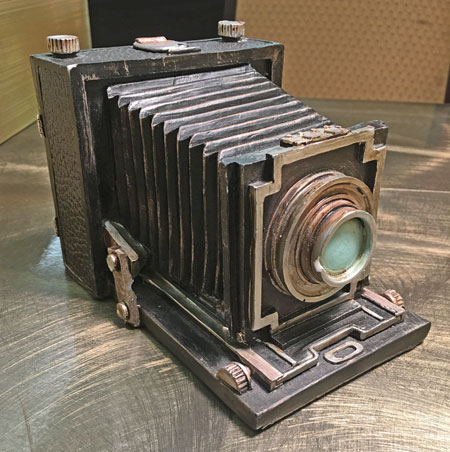

Our first collectible is a vintage camera coin bank.
It does look very much like an old, dusty camera.
Searching the internet, one finds many examples of coin banks in the shape of old cameras.
It's expected the camera banks were more an advertising gimmick than a way to hide coins in something that does not look like a coin bank.
Excerpts from Wikipedia provide background information on the early folding cameras:
A folding camera is a camera type. Folding cameras fold into a compact and rugged package for storage. The lens and shutter are attached to a lens-board which is connected to the body of the camera by a light-tight folding bellows. When the camera is fully unfolded it provides the correct focus distance from the film. The key advantage of folding cameras is their excellent physical-size to film-size ratio when the camera is folded for storage.
It does look very much like an old, dusty camera.
Searching the internet, one finds many examples of coin banks in the shape of old cameras.
It's expected the camera banks were more an advertising gimmick than a way to hide coins in something that does not look like a coin bank.
Excerpts from Wikipedia provide background information on the early folding cameras:
A folding camera is a camera type. Folding cameras fold into a compact and rugged package for storage. The lens and shutter are attached to a lens-board which is connected to the body of the camera by a light-tight folding bellows. When the camera is fully unfolded it provides the correct focus distance from the film. The key advantage of folding cameras is their excellent physical-size to film-size ratio when the camera is folded for storage.
Portable folding cameras dominated camera design from the 1890s to 1930s and were significant into the late 1940s.
The typical amateur camera of the early 20th Century made various "postcard" sized negatives around 4" × 5". By the 1930s 6cm × 9cm cameras for either the 120 or 620 film size, were highly popular.
The use of folding cameras declined in the late 1930s with advances in lens technology allowing superior enlargement, high quality images on smaller negatives, and shorter distances between the lens and the film.
Just in searching for vintage camera images online, this particular camera bank could be modeled after a Sanderson or perhaps a Houghton & Ensign early plate camera.
Regardless, this is an interesting collectible and could easily be a fun conversation piece, especially for those interested in photography.
The typical amateur camera of the early 20th Century made various "postcard" sized negatives around 4" × 5". By the 1930s 6cm × 9cm cameras for either the 120 or 620 film size, were highly popular.
The use of folding cameras declined in the late 1930s with advances in lens technology allowing superior enlargement, high quality images on smaller negatives, and shorter distances between the lens and the film.
Just in searching for vintage camera images online, this particular camera bank could be modeled after a Sanderson or perhaps a Houghton & Ensign early plate camera.
Regardless, this is an interesting collectible and could easily be a fun conversation piece, especially for those interested in photography.
Ancient Denarius - Trajan


The next collectible is very old, a Denarius showing the emperor Trajan.
From the Archaeologia Or Miscellaneous Tracts Relating to Antiquity published in 1846:
"Among the denarii, however, is one of some interest, having a Greek legend-the which must indeed have been Greek to the unlettered Brigantes:
"Obverse. (Imperator Casar Nerva Trajanus, Augustus, Germanicus.) The laureated head of the Emperor Trajan, regarding the left.
From the Archaeologia Or Miscellaneous Tracts Relating to Antiquity published in 1846:
"Among the denarii, however, is one of some interest, having a Greek legend-the which must indeed have been Greek to the unlettered Brigantes:
"Obverse. (Imperator Casar Nerva Trajanus, Augustus, Germanicus.) The laureated head of the Emperor Trajan, regarding the left.
"Reverse. (Tribunitia potestate, Consul iterum.) An owl sitting on two lyres. This coin was, no doubt, struck in Lycia ; but I cannot even safely guess at the town, nor why the symbol bears two lyres.
Nor must the owl be taken too strictly in connection with the instruments, because we sometimes meet, instead of that bird, an acrostolium of a ship, a caduceus, or other symbol.
They are classed by themselves, numismatically, all to Lycia in genere; having sometimes the letters AT on the one side or the other, placed so as to render the attribution of them certain. They occur of Augustus, Claudius, Domitian, Nerva, and Trajan."
Nor must the owl be taken too strictly in connection with the instruments, because we sometimes meet, instead of that bird, an acrostolium of a ship, a caduceus, or other symbol.
They are classed by themselves, numismatically, all to Lycia in genere; having sometimes the letters AT on the one side or the other, placed so as to render the attribution of them certain. They occur of Augustus, Claudius, Domitian, Nerva, and Trajan."
Per one Ancient coin resource, "Coin issued to commemorate Trajan's Second Consulship A. D. 98-99."
From ThoughtCo.com:
Born Marcus Ulpius Traianus, Trajan was a soldier who spent most of his life involved in campaigns. When delivered the news that he was adopted by Roman Emperor Nerva, and even after Nerva died, Trajan remained in Germany until he had completed his campaign. His major campaigns as emperor were against the Dacians, in 106, which vastly increased the Roman imperial coffers, and against the Parthians, beginning in 113, which was not a clear and decisive victory. His imperial name was Imperator Caesar Divi Nervae filius Nerva Traianus Optimus Augustus Germanicus Dacicus Parthicus. He reigned as Roman emperor from A.D. 98-117.
Although we don't know the details, Trajan set up cash subsidies to help raise poor children. He is well known for his building projects.
From ThoughtCo.com:
Born Marcus Ulpius Traianus, Trajan was a soldier who spent most of his life involved in campaigns. When delivered the news that he was adopted by Roman Emperor Nerva, and even after Nerva died, Trajan remained in Germany until he had completed his campaign. His major campaigns as emperor were against the Dacians, in 106, which vastly increased the Roman imperial coffers, and against the Parthians, beginning in 113, which was not a clear and decisive victory. His imperial name was Imperator Caesar Divi Nervae filius Nerva Traianus Optimus Augustus Germanicus Dacicus Parthicus. He reigned as Roman emperor from A.D. 98-117.
Although we don't know the details, Trajan set up cash subsidies to help raise poor children. He is well known for his building projects.
Franklin Half Dollar - Full Bell Lines
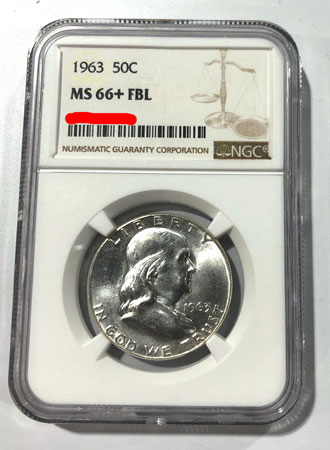
Going forward in time, the next coin is a very nice Franklin Half Dollar with Full Bell Lines.
This coin from the Philadelphia Mint in 1963 is an extraordinary specimen for a couple of reasons.
First, they struck over 22 million of the coins. With that large population, it is difficult to find coins with full bell lines.
Second, this was the last year of the Franklin Half Dollar, thus the dies were getting tired and the mint did not want to produce new dies for the last mintage year.
Third, this is graded as MS-66+ FBL. This coin graded by NGC (Numismatic Guaranty Service) and another graded by PCGS (Professional Coin Grading Service) are the only two Franklin Half Dollar Coins with Full Bell Lines with this high grade. There are no others graded higher with Full Bell Lines for that year and mint.
NGC describes their grading of the Franklin Half Dollar coin:
This coin from the Philadelphia Mint in 1963 is an extraordinary specimen for a couple of reasons.
First, they struck over 22 million of the coins. With that large population, it is difficult to find coins with full bell lines.
Second, this was the last year of the Franklin Half Dollar, thus the dies were getting tired and the mint did not want to produce new dies for the last mintage year.
Third, this is graded as MS-66+ FBL. This coin graded by NGC (Numismatic Guaranty Service) and another graded by PCGS (Professional Coin Grading Service) are the only two Franklin Half Dollar Coins with Full Bell Lines with this high grade. There are no others graded higher with Full Bell Lines for that year and mint.
NGC describes their grading of the Franklin Half Dollar coin:
"The Franklin Half Dollar series (1948-1963) is the shortest Half Dollar series after the Civil War. Relatively easy to collect, the series was cut short by the intense response to the assassination of President Kennedy, which results in a new Half Dollar series.
"The coin features the iconic Liberty Bell on its reverse. To qualify for NGC's Full Bell Lines (FBL) designation, all the horizontal lines on the bell must be distinct. Often, the strike can leave the lower bell lines incomplete. The rarity of the FBL designation varies across the series, though coins from San Francisco consistently have trouble qualifying.
"Franklin Half Dollars do not need to be Mint State to qualify for the FBL designation, but it should be no surprise that most that qualify are Mint State. The FBL designation is not used for Franklin Half Dollar Proofs, which are assumed to have been well-struck.
"The Franklin Half Dollar is the only Half Dollar with a unique strike character. Other series with unique strike characters include the Standing Liberty Quarter, the Mercury and Roosevelt Dimes and the Jefferson Nickel.
"The FBL strike character can be combined with the strike characters for "PL" (for Prooflike) and "DPL" (for Deep Prooflike), but to date, only a handful of PL Franklin Half Dollars have been certified by NGC (with no DPL ones)."
In other words, this is an excellent Franklin Half Dollar Coin.
"The coin features the iconic Liberty Bell on its reverse. To qualify for NGC's Full Bell Lines (FBL) designation, all the horizontal lines on the bell must be distinct. Often, the strike can leave the lower bell lines incomplete. The rarity of the FBL designation varies across the series, though coins from San Francisco consistently have trouble qualifying.
"Franklin Half Dollars do not need to be Mint State to qualify for the FBL designation, but it should be no surprise that most that qualify are Mint State. The FBL designation is not used for Franklin Half Dollar Proofs, which are assumed to have been well-struck.
"The Franklin Half Dollar is the only Half Dollar with a unique strike character. Other series with unique strike characters include the Standing Liberty Quarter, the Mercury and Roosevelt Dimes and the Jefferson Nickel.
"The FBL strike character can be combined with the strike characters for "PL" (for Prooflike) and "DPL" (for Deep Prooflike), but to date, only a handful of PL Franklin Half Dollars have been certified by NGC (with no DPL ones)."
In other words, this is an excellent Franklin Half Dollar Coin.
Trajan also built an artificial harbor at Ostia.
Trajan was officially designated optimus 'best' or optimus princeps 'best chief' in 114. He provided 123 days of public celebration for his Dacian triumph and had his Dacian and Germanic successes recorded in his official title. He was posthumously made divine (divus) as had his predecessor (Caesar Divus Nerva). Tacitus refers to the beginning of Trajan's reign as a 'most blessed age' (beatissimum saeculum). He was also made Pontifex Maximus.
For those who collect ancient coins, this one is graded as VF, a very nice coin for being not quite 2000 years old.
Trajan was officially designated optimus 'best' or optimus princeps 'best chief' in 114. He provided 123 days of public celebration for his Dacian triumph and had his Dacian and Germanic successes recorded in his official title. He was posthumously made divine (divus) as had his predecessor (Caesar Divus Nerva). Tacitus refers to the beginning of Trajan's reign as a 'most blessed age' (beatissimum saeculum). He was also made Pontifex Maximus.
For those who collect ancient coins, this one is graded as VF, a very nice coin for being not quite 2000 years old.
50 Pesos Gold Coin
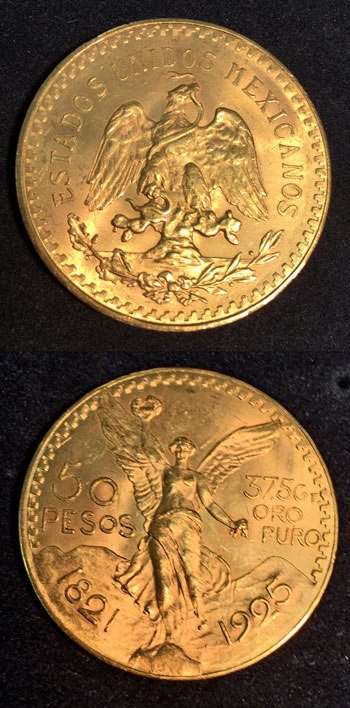
This next collectible example comes from south of the border.
It's a gold 50 pesos coin that today is primarily a bullion piece.
From APMEX, the coin highlights:
"Contains 1.2057 oz of Gold.
"Obverse: Features the iconic Winged Victory "The Angel of Independence" design.
It's a gold 50 pesos coin that today is primarily a bullion piece.
From APMEX, the coin highlights:
"Contains 1.2057 oz of Gold.
"Obverse: Features the iconic Winged Victory "The Angel of Independence" design.
20 Pesos Gold Coin

Keeping south of the border, the next collectible is a 20 peso gold coin.
It shows a date of 1959, but it may be from a later year.
APMEX describes the coin:
"The Mexican 20 Peso combines nearly half an ounce of Gold with historic appeal and a wonderfully intricate Aztec calendar design. These coins retain much of their mint luster, and show full detail with only minor wear on the high points of the design.
"Coin Highlights:
"Contains .4823 oz of Gold.
"Coins will be in Brilliant Uncirculated condition.
It shows a date of 1959, but it may be from a later year.
APMEX describes the coin:
"The Mexican 20 Peso combines nearly half an ounce of Gold with historic appeal and a wonderfully intricate Aztec calendar design. These coins retain much of their mint luster, and show full detail with only minor wear on the high points of the design.
"Coin Highlights:
"Contains .4823 oz of Gold.
"Coins will be in Brilliant Uncirculated condition.
Silver Eagle 25th Anniversary Set
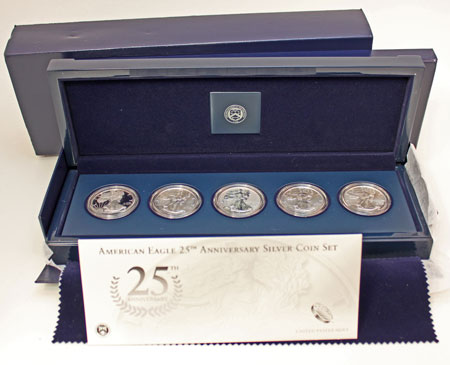
The five different silver eagles are the uncirculated coin minted in West Point, the proof coin minted in West Point, the reverse proof struck in Philadelphia, the bullion coin with no mint mark produced in either San Francisco or West Point, and the uncirculated coin minted in San Francisco.
These beautiful coins contain 0.999 troy ounce of silver each and showcase the beautiful designs by Adolph A. Weinman on the obverse and John Mercanti on the reverse in each of the different finishes.
Per the US Mint's population report, they produced a total quantity of over 40 million of the 2011 bullion silver eagles, however they show just under 500,000 for the production of the 25th anniversary coin sets.
These beautiful coins contain 0.999 troy ounce of silver each and showcase the beautiful designs by Adolph A. Weinman on the obverse and John Mercanti on the reverse in each of the different finishes.
Per the US Mint's population report, they produced a total quantity of over 40 million of the 2011 bullion silver eagles, however they show just under 500,000 for the production of the 25th anniversary coin sets.
Last on our as-seen-on-the-bourse list is a beautiful five-coin American Silver Eagle set.
The US Mint produced this set in 2011 to commemorate the 25th anniversary of the Silver Eagle program.
The US Mint produced this set in 2011 to commemorate the 25th anniversary of the Silver Eagle program.
Eight years later, this five-coin silver American eagle set still provides a beautiful collectible for its metal content and for its different Mint processes.
"Reverse: Mexico's national coat of arms featuring a golden eagle with a snake in its beak while perched on a cactus."
NGC provides this note: "During 1949-1972 a total of 3,975,654 pieces were restruck, most likely dated 1947 and an additional 388,800 pieces dated 1947 were struck during 2000-2013. In 1996 matte restrikes were produced. Mint mark Mo."
At 90 percent pure, coin contains 37.5 g of "oro puro" and weighs a total of 41.67 g.
This specimen is one of 716,000 coins minted in 1925.
Several world coin forums do caution that counterfeits of the gold 50 peso coin do hit the market on a regular basis.
This one, however, is a beautiful example of an original Mexican gold coin.
NGC provides this note: "During 1949-1972 a total of 3,975,654 pieces were restruck, most likely dated 1947 and an additional 388,800 pieces dated 1947 were struck during 2000-2013. In 1996 matte restrikes were produced. Mint mark Mo."
At 90 percent pure, coin contains 37.5 g of "oro puro" and weighs a total of 41.67 g.
This specimen is one of 716,000 coins minted in 1925.
Several world coin forums do caution that counterfeits of the gold 50 peso coin do hit the market on a regular basis.
This one, however, is a beautiful example of an original Mexican gold coin.
In addition, they note the coin has edge lettering: "INDEPEDENCIA Y LIBERTAD."
At not quite a half ounce of precious metal, this is a still a beautiful addition to any gold coin or bullion collection.
At not quite a half ounce of precious metal, this is a still a beautiful addition to any gold coin or bullion collection.
"Obverse: Mexican coat of arms featuring a Golden eagle perched atop a cactus, devouring a snake. Date below wing.
"Reverse: Aztec Calendar Stone above legend bearing denomination and metal content.
"Issued by Banco de México from 1917-1921 and again in 1959.
"Mexican Gold Pesos represent an extraordinary opportunity to own historic Gold coins in a variety of sizes at relatively low premiums."
NGC adds this information to their description: "During 1960-1971 a total of 1,158,414 pieces were restruck, most likely dated 1959. In 1996 matte restrikes were produced. An additional 95,300 pieces dated 1959 were struck in 2000-2013."
"Reverse: Aztec Calendar Stone above legend bearing denomination and metal content.
"Issued by Banco de México from 1917-1921 and again in 1959.
"Mexican Gold Pesos represent an extraordinary opportunity to own historic Gold coins in a variety of sizes at relatively low premiums."
NGC adds this information to their description: "During 1960-1971 a total of 1,158,414 pieces were restruck, most likely dated 1959. In 1996 matte restrikes were produced. An additional 95,300 pieces dated 1959 were struck in 2000-2013."
